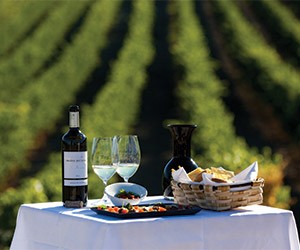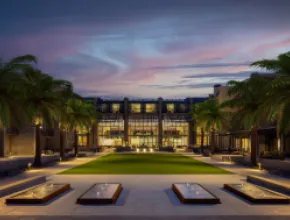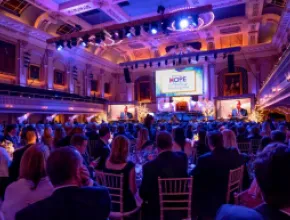While firmly rooted in the past, Spain never seems to stop reinventing itself. Whether it’s the Old World, the cutting-edge or a combination of both, experiential and inventive are the operative words when it comes to memorable opportunities for groups. And three top trends shaping the agenda nowadays are unforgettable venues, gastronomy and emerging destinations.
Vibrant Venues
Spain’s best-of-both-world’s ambience means groups can gather in centuries-old structures oozing with character and dynamic contemporary creations of famous architects such as Santiago Calatrava, Rafael Moneo or Frank Gehry.
“The availability and use of very special venues has become a big trend in cities like Madrid and Barcelona, and in smaller destinations like Seville, Bilbao and Valencia,” says Carola Sesena, director of the Tourist Office of Spain in Chicago, pointing to options such as Madrid’s world-class museums and Galeria Cristal (see “Spotlight: Madrid,” page 27), Bilbao’s celebrated Guggenheim Museum and country houses in Andalucia and Valencia.
In Barcelona, Antonio Gaudi’s fantastical creations such as the Sagrada Familia cathedral, Park Guell and the event-ready Casa Batllo reign supreme for architectural buffs. One unique way groups can immerse themselves in all things Gaudi is at G Experiencia, an innovative event venue that features a 4-D presentation on Gaudi, with 3-D audiovisual technology as well as moving seats and air and water effects.
Meanwhile, Spain’s paradors, combining history, art, cuisine and spectacular settings in castles, monasteries, convents and other distinctive buildings, are a treat for small groups.
“The paradors have been promoting themselves as MICE destinations, and they offer a very authentic Spanish experience for meetings,” says Patricia Wood Winn, press and public relations manager for the Tourist Office of Spain in Chicago, pointing to several standout options with meeting facilities.
One of the newest is Parador de Alcala de Henares near Madrid. It is housed in a 17th- century monastery but features a modern, minimalist interior. Another great choice for groups is Parador de Caceres, set in the historic heart of the city of Caceres, a UNESCO World Heritage Site, and next to Atrio, a Michelin-star restaurant. Caceres, famous for its rich meat stews and cheeses, was named Spain’s Culinary Capital for 2015. Groups should also check out Parador de San Francisco in Grenada on the grounds of the Alhambra, Parador de Hondarribia outside San Sebastian and Parador de El Saler in Valencia.
Tastefully Yours
Few destinations can match the diversity of food and wine experiences Spain serves up. From classic dishes to the “deconstructivist,” molecular gastronomy of acclaimed chef Ferran Adria and others who continue to blaze new culinary trails, Spain has been referred to by many, including No Reservations TV show host Anthony Bourdain, as the best country in the world for food, not to mention wine. Rioja anyone? With 145 Michelin-star restaurants and counting, an irresistible tapas culture and nine Denomination of Origin (DO) wine regions, Spain’s gastronomy scene is trending big time.
One of the best places to savor Spain is the Basque Country and its alluring city of San Sebastian, the birthplace of pintxos (small plates) and home to some of the world’s best restaurants.
To experience the region like a local, planners can look to renowned food expert Gabriella Ranelli, a New York native who has lived in San Sebastian for more than 20 years. She is the founder of the tour company Just in San Sebastian, Tenedor Tours and Gabriella’s Kitchen.
“We listen to our clients to build upon the most dynamic, well-liked aspects of their previous trips to create something completely new here,” she says. “We always include food and wine, and cooking classes, pintxos tours, wine-tasting programs, and dinners at Michelin-star restaurants like Arzak and Mugaritz are a big part of it. We’re in the middle of four wine regions, including Rioja, Txakoli de Getaria, Navarra and Bordeaux across the French border.”
Ranelli recently teamed up with Renfe, Spain’s national rail system, to launch Rioja a Todo Tren, the first-ever private wine train from Barcelona to Rioja. Groups of up to 22 people are treated to a four-hour private rail trip, complete with an immersive wine- and food-pairing program focusing on Basque cuisine. In Rioja, they embark on a two-day adventure spotlighting its history, culture and culinary riches, including winemaker dinners, private winery tours, tastings and spa experiences.
In Madrid and Barcelona, the foodie scene is as inventive as ever.
“Two of the biggest trends in Madrid are Michelin-star chefs opening super cool, middle-tier establishments and they’re also doing very unique ethnic fusion,” says Norema Salinas, director of Norema Salinas Catering in Madrid.
Her newest go-to hot spots are DStage, Punto MX, Street XO, Sala de Despiece and Academia del Despiece, and Sudestada.
Barcelona’s ever-changing culinary landscape is just as innovative when it comes to new celebrity chef establishments such as Bar Bas, BistrEau, Disfrutar, Doble, El Informal and El Nacional.
Emerging Locales
While Madrid, Barcelona and Andalucia are Spain’s top meetings destinations, lesser-known areas are becoming increasingly popular.
“Valencia, some of the smaller cities in Andalucia and places in the northern part of Spain such as Bilbao are making a big effort to promote themselves for meetings,” says the Tourist Office of Spain’s Sesena.
Valencia is a magnetic destination along the sea, with historic districts set against modern structures like L’Hemisferic City of Arts and Sciences, as well as authentic group offerings such as paella-making classes.
Meanwhile, Pamplona is another up-and-coming group choice, with its historical ambience, Ernest Hemingway heritage, state-of-the-art Baluarte Conference Center and Auditorium, and annual San Fermin Running of the Bulls festival.
LORI TENNY’s favorite Spanish pastime is indulging in the “Tapas Quarter” of San Sebastian—Disneyland for foodies.







